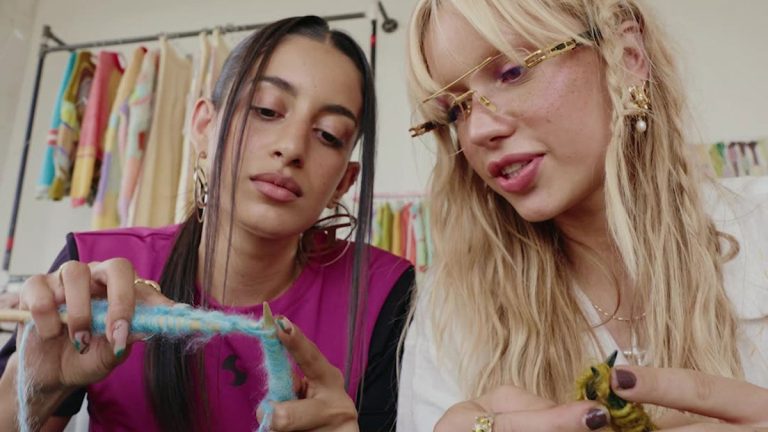Similarly, Taylor believes there’s a sense of candidness to It Girls that viewers respond well to. “I think the audience enjoys the short-form format and the opportunity to see different outfits and different women in their casual street style looks,” she explains.
Some of the shows are opening up the inner sanctums of fashion to the consumer. For example, designer and founder of Knorts Eleanore Guthrie hosts a YouTube series documenting the intricacies of running her independent knit-denim brand. “I share things like showroom meetings, stylist pulls, design development, knitting on my knitting machines, the process of designing and developing a knit-denim collection for Urban Outfitters, phone calls, photoshoots etc,” she says. “I want [people] to see and better appreciate the process behind how Knorts end up in their wardrobe.”
What brands need to consider
The sponsorship opportunity is clear, but creators say they prefer to integrate their partners into the shows in some way, to make it feel more organic. The first episode of Clarafied, for example, was sponsored by Urbn-owned rental subscription service Nuuly, and the participant was given a complimentary subscription as well as styling by Perlmutter in the first month’s selection of clothes; the second was backed by dating app Hinge, whereby the participant’s Hinge profile was given a makeover.
Taylor has partnered with the likes of Rotate Your Closet and Ramy Brook. “We work with brands to create content that aligns with our show such as sponsored episodes,” Taylor says. “We can interview New Yorkers on the street to talk about a brand, a launch, their favourite trends and tie it back to a fashion brand or feature their founders in a paid ad that appears in an ‘It-girl’ interview.” The series has also filmed episodes at activation pop-ups, showcasing attendees and asking them questions selected by the brand.
Saber, meanwhile, held off on getting sponsors for the first season of Behind the Scene. “We wanted to establish a tried-and-true format and didn’t want to compromise so early on the integrity of the show,” she says. “For the next seasons, we’re opening up bespoke creative integrations with partner brands for both the overall season as well as episodic integrations.” She’s planning to go behind the scenes at New York Fashion Week with some of her favourite brands in September, including creating some paid-for content.
Coilero advises that brands adapt to new audience standards. “They should allow creators to have full control over how the product is displayed to maximise authenticity and engagement,” she explains. “Consumers don’t want to be sold to; they want to be entertained.” With this, she says, brands shouldn’t fear unlikely partnerships with niche creators — consumers crave conversation and novelty, and this could be a great way for a brand to stay culturally relevant.
Meta’s Chen agrees, noting that traditional sponsored content can feel more surface level, but thinking beyond the standard OOTD video or try-on haul will empower creators to partner with brands in a more organic way. “Brands that want to participate in this trend should lean into the authenticity,” she says.
Comments, questions or feedback? Email us at feedback@voguebusiness.com.
The Instagram era of influencer brands is over. What now?
Brands vs. influencers: Who holds more power?
How the Notes app became Gen Z’s Clueless outfit generator


